The field of contact mechanics, encompassing the development of theories and numerical formulas for diverse applications, is rapidly advancing. This publication concentrates on rolling contact issues in both tire-road and wheel-rail scenarios. For tire-road interactions, a key challenge is modeling the tire’s composite structure under internal pressure and axle load. A significant focus is the rolling behavior on soft soil, which is highlighted as a primary application. In contrast, the wheel-rail contact problem involves a much smaller contact area, necessitating a detailed examination of material changes, wear, and creep phenomena. The publication also explores a recent finite element formulation based on the arbitrary Lagrange-Eulerian method. Additionally, the discussion includes insights into damage mechanisms.
The problem of rolling contact, whether for tire-road or wheel-rail interactions, remains an area of active research. With the growing power of modern computers, there is an increasing emphasis on three-dimensional models for numerical simulations, incorporating additional factors such as temperature effects and their impact on creep. However, empirical models and simplified, lower-dimensional representations are still necessary for efficient simulations, such as those required for modeling car dynamics with external tire mechanics.
Since Elkins’ significant state-of-the-art review [1,2], there have been substantial advancements, although challenges like precise wear prediction remain unresolved. This article addresses both rolling contact topics comprehensively, providing detailed insights into the historical development and recent advancements in applicable theories and computational methods for each topic.
Pneumatic tire mechanics is divided into two main sections: external tire mechanics, which addresses the effects of tires on vehicle dynamics, and internal tire mechanics, which focuses on computing stress, strain, heat states, and service life based on loading, structural design, and material properties. The link between these sections is the output characteristics of tires, which impact vehicle performance [2].
External tire mechanics, also known as elastic wheel mechanics, has a longer history of development compared to internal tire mechanics. This field began with ring or shell-type models to calculate tire characteristics and relied heavily on experimental data or simplified models [3]. With advancements in internal tire mechanics—using complex models of tire structure—there is now an opportunity to enhance external tire models in vehicle simulation systems. New approaches in external tire mechanics, including applications to rolling contact on deformable ground.
Internal tire mechanics employs models based on physical principles rather than solely empirical data. The rubber-cord shell model, representing a laminated reinforced structure, is a prime example. Investigating these composites is challenging due to factors such as:
Significant anisotropy from the differing elastic moduli of cord and rubber.
Large transverse shear deformation in rubber interlayers, which can lead to delamination.
High structural flexibility requiring a nonlinear approach.
Theories for cord-rubber structures, especially for diagonal tires, have seen significant development. Research in internal tire mechanics began in the late 1920s and early 1930s at tire manufacturing companies, leading to advances such as the equilibrium configuration theory based on the momentless netlike shell model. The application to tire calculations was delayed. The equilibrium configuration theory assumes non-extensibility of cord threads and minimal forces in the rubber [4]. Comprehensive reviews of netlike shell models are presented by author [2], provides a state-of-the-art review of tire calculations using these models.
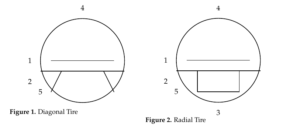
Research on pneumatic tire mechanics expanded to universities, incorporating advances from composite mechanics, shell theory, friction and wear theory, viscoelasticity, and dynamics of non-holonomic systems. Prominent scientific figures included. Progress in diagonal tire calculations included membrane theory and classical bending theory of layered shells, leading to finite element methods developed by Tielking. Commonly used tire models, such as the ring on spring bedding and the pneumatic rotation shell, are illustrated in Figures 2 and 3.
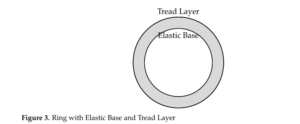
For radial tires, the fundamental structural differences prevent the use of models designed for diagonal tires. Early radial tire models, such as Böhm’s double membrane model for the belt and carcass layers, address the distribution of forces between these layers [5,6].
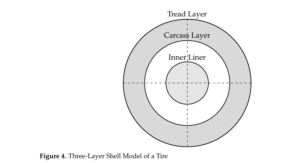
In the late 1960s, researchers began applying the Finite Element Method (FEM) to calculate the stress-strain state of pneumatic tires under various loads. This advancement allowed for more complex modeling of tires, treating them as three-dimensional bodies. Initially, universal FEM programs such as NASTRAN, MARC, and ADINA were utilized to analyze tires subjected to internal pressure and contact loads using both shell and three-dimensional models [7]. However, there was often only approximate agreement with experimental data.
The discrepancies between calculations and experiments arise from the unique behaviors of the rubber-cord tire structure, which limit the effectiveness of general-purpose FEM packages. Discussions on FEM applications for tire calculations highlight these limitations.
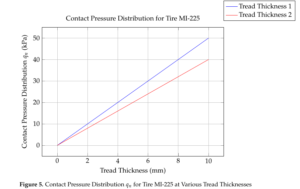
To address these challenges, there was a push to develop specialized FEM programs or enhance existing ones with new elements tailored for pneumatic tire calculations. Contributions in this area include the development of shell elements, orthotropic body elements, and anisotropic body elements, as well as methods for modeling rubber behavior.Off-road, giant, and agricultural tires, which operate under special conditions such as low inner pressure (0.08 to 0.25 MPa) and low speeds, have been studied separately.
Currently, researchers are developing more complex three-dimensional tire models that account for many operational states (e.g., rolling tires). However, these advanced FEM models require extremely powerful computers and high accuracy in input data, limiting their practical use in car dynamics. Consequently, simpler models, including one-dimensional and two-dimensional approaches, remain relevant and are continuously refined. For example, rolling tires on rigid surfaces have been modeled as elastic bedded ring beams, providing reliable results for practical applications [8].
The calculation of the stress-strain state of a tire in rolling contact with rigid and pliable surfaces, as well as the determination of contact parameters such as the contact area and forces, is crucial for advancements in vehicle dynamics and tire design [9]. These calculations require complex tire models, such as shell or three-dimensional models, due to the specific mechanical and physical behavior of rubber-cord composites and how contact impulses propagate through the tire.
Rubber can endure significant strains without failure, with a non-linear stress-strain relationship. Additionally, the properties of rubber are highly temperature-dependent. Dynamic loading induces rubber deformation and failure patterns that differ substantially from static loading conditions, making static analysis insufficient for capturing the energy losses observed in experiments with oscillating and rolling tires [10].

The variational technique is a fundamental method for addressing the contact problem between the tire and the surface. This method converts the contact boundary problem into a variational inequality or equality problem, which can then be solved using non-linear programming methods. Friction effects can also be incorporated into this approach to determine the contact area and forces. Simplified assumptions about adhesion and sliding zones can aid in obtaining contact forces more effectively. Key works in this area include contributions on variational inequalities, variational equalities, and rolling contact [11].Calculations of tires under local normal forces using orthotropic shells of rotation have been explored. Key areas of research include:
Solutions to contact problems in shells, focusing on orthotropic and anisotropic behaviors. Recent developments in shell models for tire contact calculations have focused on obtaining stress-strain and heat fields for quasi-static contact problems. The numerical solution of the contact boundary value problem depends on the shell theory used, which must account for:
Anisotropy effects
Inhomogeneity effects
Geometrical non-linearity
Thus, there is a need to develop a non-linear discrete-layer approximation theory for initially stressed multilayered anisotropic shells, using the natural membrane state as a foundational basis.
The normal contact problem for two bodies with surfaces of second degree was initially addressed by Hertz, who considered both bodies as elastic half-spaces. The classical solution for the rolling contact problem was provided by Carter and Fromm. Carter solved the integral equation for a cylinder rolling on a plane, while Fromm addressed the case of a cylinder rolling inside a hollow cylinder. These solutions remained the primary ones for over 30 years.
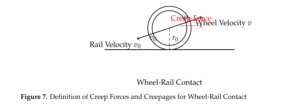
For the wheel-rail contact problem, which requires a three-dimensional solution, approximations or numerical methods must be employed. Early solutions for special cases were presented by Johnson, and Haines and Ollerton [12]. A notable development was the approximate solution by Vermeulen and Johnson, which provided a closed-form solution for rolling contact including longitudinal and lateral creepages. To address the most general cases, the contact patch must be discretized and solved using boundary element methods. Kalker’s methods are among the most successful in this area, with detailed descriptions available in his book and survey papers.
Kalker’s CONTACT program handles arbitrary surfaces of the contacting bodies, resulting in non-elliptic contact patches. It can accommodate longitudinal, lateral, and spin creep, and offers both linear and non-linear, steady-state and non-steady-state solutions [13]. However, there are some limitations:
The high computational time of CONTACT makes it challenging to use in real-time vehicle dynamics analysis. To address this, Kalker developed FASTSIM, an approximate solution method that models the contacting bodies using an elastic foundation rather than elastic half-spaces. Another fast and reliable approach is the modified Vermeulen-Johnson theory by Shen. For non-steady-state problems, such as curve squealing or dynamic analysis of wheels on corrugated rails, a non-steady-state analysis is necessary.
CONTACT relies on the half-space assumption, which is valid for small contact dimensions relative to curving radii. However, this assumption fails for contact near the gauge corner, necessitating a finite element model.
While CONTACT can handle friction coefficients depending on state variables like local sliding velocity, solutions for these problems are not covered in Kalker’s book.
CONTACT allows for arbitrarily fine discretizations, making it possible to consider rough surfaces with extensive discretizations. Although two-dimensional solutions are available for micro-roughness, three-dimensional analyses have not yet been performed using CONTACT.
CONTACT is limited to elastic problems and cannot address plastic deformation in the rail head.
Rolling contact presents unique challenges due to its nonlinear nature and the complexities introduced by high-speed rotation and varying contact areas. Finite Element Methods (FEM) have been developed over the years to handle various nonlinearities, including mechanical and thermomechanical contact. For detailed information on FEM in this context, consult works [14].
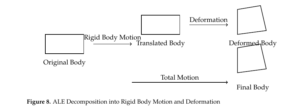
Multiple Rotations: Rolling contact involves the continuous rotation of the wheel or tire, which adds complexity to the problem. This requires managing the periodic re-meshing of the contact area to maintain accuracy throughout the rolling process.
Contact Area Dynamics: Unlike common contact problems, the contact area in rolling contact covers only a small part of the surface, and accurate pressure and shear stress distributions, including proper subdivision into sticking and sliding regions, necessitate very fine discretization of the contact area and its surroundings. Although adaptive remeshing can help, it struggles with the frequent re-meshing needed as the wheel rolls.
The development of specialized FEM codes for rolling contact began in the early 1980s [15]. Initial solutions were approximations, as contact conditions were often formulated with displacements rather than velocities. Over time, more sophisticated approaches have emerged, including the Arbitrary Lagrange-Eulerian (ALE) formulation, which allows for moving meshes over the material body.
Complexity of Application: The ALE approach can handle moving boundaries and surfaces, but applying it to rolling contact, particularly with complex geometries like tire profiles, remains challenging. This complexity may explain why ALE formulations are not widely used for tire modeling. Finite Element Methods and Contact Phenomena:
Numerical Methods: For wheel-rail contact, dense discretization in the contact area is employed to achieve accurate results. Theoretical details on the FEM using ALE formulation are available in sources like Zastrau and Nackenhorst.
Contact Models: Various approaches exist, ranging from atomistic models dealing with surface roughness to simpler Coulomb models. Penalty methods with ’preview’ techniques have been introduced to approximate contact behavior considering surface asperities. However, accurate tangential contact modeling remains a challenge, as it should be velocity-based rather than displacement-based.
Sticking vs. Sliding: In sticking contact, velocities at the contact point must be identical, while in sliding contact, the velocity direction must align tangentially with the surface. These conditions depend on both the time derivative of the motion and the displacement gradient at the contact point.
Augmented Lagrange Approach: For numerical evaluations of rolling contact, the augmented Lagrange approach is commonly used to handle the complexities of the contact problem.
Over the past 15 years, rolling contact fatigue (RCF) has gained attention due to its significant impact on rail maintenance costs. Particularly in curved tracks, grinding of the gauge corner on the high rail is necessary to address head checks, a critical RCF damage phenomenon [16]. It is widely accepted that RCF and head checks result from the overloading of rail material.
To evaluate the criticality of stresses experienced by a wheel rolling over a rail, shakedown maps are employed. These maps provide a way to determine whether stresses will lead to permanent deformation or whether the material will reach a stable, elastic state after initial plastic deformation.
Johnson first demonstrated the concept of a shakedown limit for rolling contact in 1962/63. His work, further elaborated in subsequent surveys, showed that a shakedown limit exists, where continuous plastic deformation becomes inevitable if the limit is exceeded.
For the simplest case of line contact (plane strain), where a cylinder rolls over a plane, the material initially undergoes plastic deformation if the load surpasses the elastic limit. After unloading, these deformations result in residual stresses. Successive wheel passages can bear higher loads without further plastic deformation if the shakedown limit is not surpassed.
The diagram below shows a shakedown map for elastic-perfectly plastic material and kinematic hardening material laws:
Vertical Axis: Represents the normalized load factor, \(\frac{p_0}{k}\), where \(p_0\) is the maximum Hertzian pressure and \(k\) is the shear yield stress.
Horizontal Axis: Displays the traction coefficient \(\frac{T}{N}\), where \(T\) is the traction force and \(N\) is the normal force.
Interpretation: The map indicates that if the traction coefficient \(\frac{T}{N}\) is sufficiently small (\(< 0.25\)), plastic deformations occur in the bulk. For \(\frac{T}{N} > 0.25\), the highest plastic deformations are found at the surface. If the shakedown limit is exceeded, continuous plastic deformation is unavoidable, leading to surface phenomena like ratchetting and eventual formation of head checks.
Material Laws: Real rail materials exhibit complex behavior, combining hardening and softening effects as described by Chaboche-type material laws. Shakedown maps for these laws are not yet available, but simulations suggest that the shakedown limit might be increased.
Interaction with Wear: The interplay between plastic deformation (ratchetting) and wear is not well understood. The mutual influence of these factors remains a topic of ongoing research.
In summary, shakedown maps are a crucial tool for understanding rolling contact fatigue and predicting potential damage. However, the complexity of real rail materials and the interaction between different damage mechanisms continue to pose challenges in accurately modeling and mitigating RCF.
In conclusion, rolling contact fatigue (RCF) represents a significant challenge in rail maintenance due to its impact on both operational efficiency and maintenance costs. The development and use of shakedown maps have advanced our understanding of how stresses from rolling contact lead to permanent deformations and potential damage such as head checks. These maps are crucial for evaluating the limits of rail material under various loading conditions and predicting when plastic deformations will occur.
Despite the progress made, there are still considerable challenges in accurately modeling RCF due to the complex behavior of real rail materials and the interaction between plastic deformation and wear. The existing material laws, such as the Chaboche-type laws, offer some insights but lack comprehensive shakedown maps. Furthermore, the relationship between wear and plastic deformation remains an area of active research.
Ongoing advancements in computational methods and material science are essential for improving the accuracy of predictions and developing more effective strategies for mitigating RCF. As research continues, the integration of detailed material models and the refinement of numerical techniques will play a critical role in enhancing the understanding and management of rolling contact fatigue in rail systems.